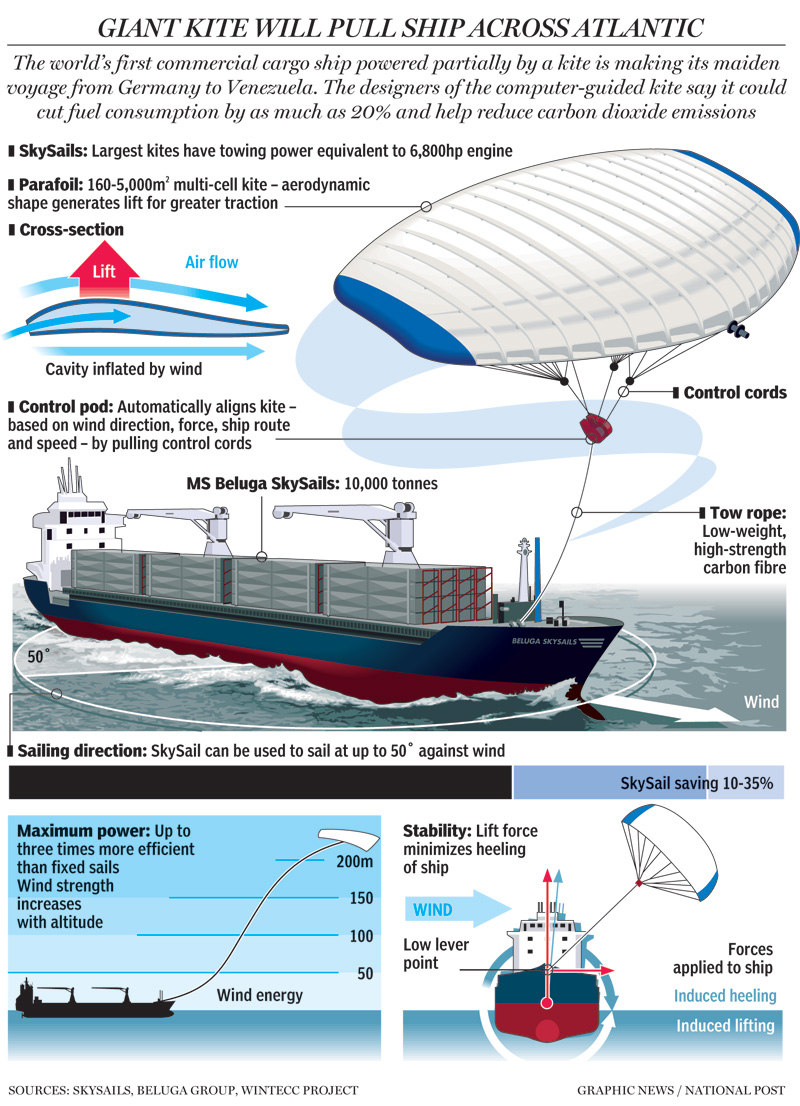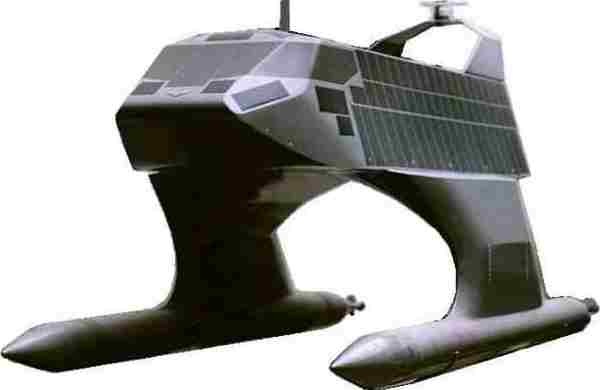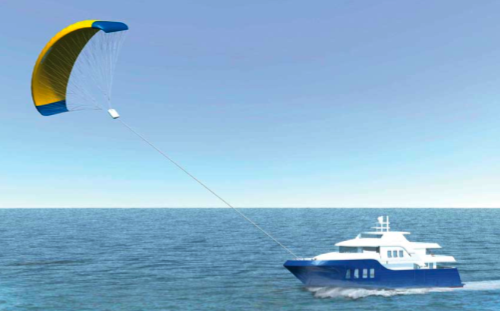
From the gCaptain Archives:
In honor of the EPA’s Pollution Week, let’s take a look at an archived post on Skysails. But first, here is a brief update into the current state of affairs provided by Skysails:
Within the framework of the pilot phase, the SkySails-System is being explored on board the MS “Michael A.” and the MS “Beluga SkySails” during regular shipping operations. Throughout these trials the system’s level of robustness and reliability is first of all being elevated to that demanded by our customers and its suitability for daily use established. Subsequently the system’s performance will be evaluated extensively and optimized.
On both ships – the “Michael A.” and the “Beluga SkySails” – the SkySails-System has been put into operation successfully. The customer vessels remain in regular commercial operation throughout the pilot phase. Initially, two to three SkySails engineers will be aboard of each ship. All components are being long-term tested during use of the SkySails-System on board. The results immediately flow into the process of improving and optimizing the product. Read full update…
On her maiden voyage, the Beluga SkySails set sail to Venezuela from Bremen on January 22, 2008 and reached the Norwegian port of Mo-I-Rana on March 13, 2008 after travelling a total of 11,952 nautical miles.
Archived post originally posted in Jan. ’08.
Three years ago at the World Expo in Aichi Japan SkySails promised a revolutionary design with the ability to reduce fuel consumption aboard ship by up to 24%. Last week the dream became reality. BBC News tells us:
There is something rather magical about being up on deck of a giant cargo ship as it pushes its way out to sea. Ten thousand tonnes of metal heaving through the water, the ship’s giant masts glistening in the winter sun. But there is something even more magical about being aboard MS Beluga SkySails. On the face of it, this vessel – which is carrying parts of a timber production line to Venezuela – looks like any other cargo ship.
MS Beluga SkySails believes its fuel bill will be cut by £800 ($1,560) a day. “We can demonstrate that you can combine economy and ecology,” Verena Frank of Beluga Shipping explains. “Economy, because you can reduce fuel consumption and fuel costs, and on the ecological side of things, we reduce emissions.”
The kite is controlled by computers. One computer helps it to fly in figures of eight in the sky – maximising the power it produces. Another computer adjusts the kite’s direction. If the project is successful, expect to see even bigger kites soon – some up to 5,000sq m (53,820sq ft) in size pulling ships across the seas and oceans. Read More…
Video
[flv:http://s3.amazonaws.com/gcaptain-s3/maritime/video/jan08/Beluga%20Sky%20Sail.flv 320 200]
Also be sure to watch National Geographic’s Profile of SkySails.
Background

In 2001 skysails started with the development of
the world‘s first practicable towing kite propulsion
system for commercial shipping and luxury yachts.
then after five years of intense developmental work,
the basic research and engineering was completed
near the end of 2005. In early 2006 the final
development phase prior to the market launch of the
skysails-system began on board the approximately
55-meter buoy-laying vessel ms “Beaufort“.
The first skysails-systems are being installed on pi-
lot customer cargo ships in 2007.
Partnership
The MS Beluga SkySails, will carry the first parts of a complete particle board factory from Bemen to Venezuela on behalf of DHL Global Forwarding, the ocean and air freight carrier of the Deutsche Post World Net Group. The multipurpose vessel will set sail early next week. What makes it so special is a new wind propulsion system with a huge towing kite that provides additional thrust for the ship at sea – a sustainable solution for reducing fuel consumption, costs and emissions.
Why
The economic force driving the resurgence of interest in wind power is the rising cost of fuel oil, which has topped $100 a barrel in futures markets. A freighter’s fuel consumption can be cut by 10 percent to 15 percent if a kite is used to pull the ship.

In addition to fuel costs, ship emissions is an important environmental topic for the shipping industry. In a 2007 report published by The Environmental Science and Technology Journal 60,000 deaths per year worldwide were attributed to vessel emissions. The following map charts the annual increase in sulfur emissions in the world’s shipping lanes.

The Technology

(Source: National Post)

(Source: SkySails Brochure)

(Source: BBC News)
Beluga SkySails in the media:
The Competition
SkySails is not the only company looking to provide alternative energy solutions to power commercial ships. From solar sails to wing kites various companies worldwide are looking for solutions that will benefit the environment and cut down on high fuel costs. Lets take a look at some of the technology currently being developed.
KiteShip

KiteShip – 2006 was been a good year for the California-based company KiteShip, which makes “very large free-flying sails”— basically, giant traction kites that harness the wind to pull very large free-floating objects. If you’ve ever gone to the beach and seen someone kite-surfing — standing on a board while being pulled by a kite — then you’ve seen a traction kite in action. KiteShip currently sells the Outleader, which helps increase yacht speeds. And it is working to improve the range and the speed of fast ferries and oceangoing research vessels without burning more fuel. Dave Culp, the engineer who helped found KiteShip, calls the three-person operation a “micromultinational.” Read More…
M/V Orcelle

M/V Orcelle – At 820 feet long ‘Orcelle’ is shorter than the Queen Mary 2 (1,132ft) and the QE2 (963ft). The ship is called the E/S Orcelle after the Orcelle Dolphin – the French word for Irrawaddy dolphin, one of the world’s most critically endangered species. The E/S stands for “environmentally sound ship”. The vessel will include a cargo deck the size of 14 football pitches. Wave energy is to be harnessed by 12 dolphin like fins an the ships hull. While, sun and wind energy is collected by three giant rigid wingsails, also covered in solar panels. Read More at SolarNavigator…

Related Links: Green Flagship Homepage | PDF Brochure | Solar Shipping Links
Solar Navigator

M/V Solar Navigator Swath – the Solar Navigator started out as a SWATH design, first exhibited at Earls Court in 1995. Since that time various wave piercing models have been developed and tested, the aim being to improve performance and reduce build costs. Both teams estimate similar travel times. One day it may be possible to travel around the world on solar power, in under 80 days. Jules Verne would have loved this. See also, the Swiss Transatlantic Sun 21 attempt using the almanac below. Read More…
Related Links: Building the SWATH Model | ZDnet Article | CNN Coverage
Magenn Air Generator

Magenn Air Generator – While designed for shore based power stations, not ships, could they one day be repurposed? ”
Magenn’s system is a lighter-than-air wind turbine capable of powering a rural village – the 30 metre wide, helium-filled “Air Rotor System” contains a turbine that spins around a horizontal axis and can produce 10 kilowatts of energy as it floats above the ground while attached to a copper tether. Larger models — ones that might power a skyscraper — are also reportedly in the works. The company claims the governments of India and Pakistan have expressed interest in the first version. Magenn is planning to launch a 1kw prototype (costing around C$1 million) into the air above Ottawa this (northern) spring.” Read More…
Related Links: Laddermilk Kites
|
AquaSailor

AquaSailor – The concept involves a series of supertankers specially designed and constructed for the carriage of potable water. The water is transported onto land through small, offshore facilities known as Single Point Moorings (SPMs). Using unique Solar Wing sails with solar cell array technology reduces fuel consumption and emissions by nearly 50% on the voyages compared to the conventional tanker of this size and hydrodynamic characteristics.

LNG As Propulsion

LNG Propelled Cruise Ship – As part of its development work, Wärtsilä has developed a new coastal cruise ferry using liquefied natural gas (LNG) as fuel. LNG is an efficient way to cut emissions. All SOX emissions are eliminated and the NOX and CO2 emissions are reduced by about 80% and 20% respectively (see figure 1). LNG is not only an environmentally sound solution, but also economically interesting at today’s oil prices.
The new ferry is designed for cruising along the Norwegian coast between small coastal communities. As this still represents a relatively untouched natural landscape, an environmentally friendly ship solution is required. The same ship and machinery concept could also be applied easily to other passengership operations, such as short-route ferries and expedition cruise vessels. Read More…
Increasing Efficiencies
Floating On Bubbles Of Air

Bubbling Ship – One promising solution derives from the work of Yoshiaki Kodama, director of the Advanced Maritime Transport Technology Department at Japan’s National Maritime Research Institute (NMRI) in Tokyo. Kodama’s team proposes to shoot a layer of bubbles from slots near the bow of the ship. The bubbles will travel along the hull of the ship, with enough bubbles trapped under the ship’s surfaces so that the constant replenishment is sufficient to maintain the blanket of bubbles. Read More…
Shark Skin Coatings

SharkSkin Coatings – To find a way to persuade algae to move on rather than killing them scientists at the University of Florida turned to nature. Sharks don’t have algae or barnacle problems despite being underwater all their lives. Shark skin is made up of tiny rectangular scales topped with even smaller spines or bristles. This makes shark skin rough to the touch. This irregular surface makes it difficult for plant spores to get a good grip and grow into algae or other plants. Read More…
Boats
Much of the technology being developed for shipping companies with big budgets and fuel costs will trickle down to our smaller coastal friends. Here’s a look at green initiatives for boaters.
Solar Sailor

Solar Sailor – Hybrid marine power combines electric drives with the power and range of hydrocarbon and/or alternative fuels. Solar panels charge the electric engines to offer better acceleration, quicker emergency stopping and easier handling. Although useful for applications such as tourism, recreation and fishing, they also under scrutiny for duty as urban ferries, where they would use 50% less fuel, generating a correspondingly 50% less emissions. Passengers also experience less noise, vibration and fumes. But the solar wings are not passive. They can be adjusted, so as to act like real cloth sales, … … with boat speeds of 8-10 knots having been achieved, cutting fuel consumption even further. If wind speed hit 35 knots, a computer lowers the sails into the roof where they offer zero windage. A 140 passenger craft, with speeds of 20 knots has more recently been developed. Read More…
Related Links: SolarSailor FAQ | Treehugger Profile | Company Homepage
Windmill Turbine Boats

Windmill Turbine Boats – While small dingy’s have been tested using windmill turbine design, the inventor hopes this to be a technology used on future vessels of all sizes. His estimated date for first launch? 2028

Related Links: Inventor’s Page | Treehugger Article
SkySails SuperYacht

SkySails SuperYacht – Humphreys Yacht Design, together with SkySails, will be exhibiting the concept for a high-performance hybrid super yacht at this year’s Monaco Yacht Show. Powered by SkySails, this 40-meter trimaran can reach speeds of up to 18 knots without the help of its main engine, and up to 30 knots with the main engine. Naturally the two power sources can be used in combination to conserve fuel. With SkySails a shaft-driven generator can be activated, which charges batteries that can supply the main diesel-electric propulsion as needed. This way, with suitable wind conditions, the hybrid yacht can be powered without having to depend on oil. Yacht owners can now sail in a way that is ecologically responsible, without having to sacrifice the comfort they’ve come to enjoy. And, this type of propulsion provides owners a high degree of security and independence in times of crisis. Read More…

 Join The Club
Join The Club































